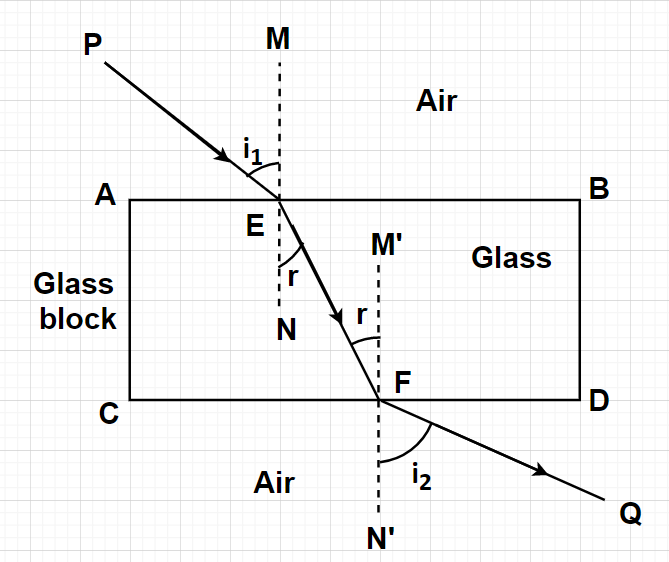
How is the angle of emergence
Answer
514.8k+ views
Hint: Here, we will proceed by assuming a glass slab placed in air and then, we will pass a beam or ray of light through in order to have the required relation between the angle of incidence and angle of emergence.
Complete Step-by-Step solution:

In order to find the relation between the angle of incidence and the angle of emergence, let us consider a glass block with opposite sides being parallel placed in air as shown in figure. One rectangular face ACDB of this glass block is shown in figure.
As we know that whenever a ray of light passes from one medium to another medium having different refractive indices, refraction occurs.
Let us observe a ray of light PE incident on this glass block. Here, at the incident surface (i.e., at point E) the ray of light passing through the air medium to glass will undergo refraction because the medium is changing (and hence the refractive index is also changing). Let the angle of incidence be
According to Snell’s law (or second law of refraction), for a light ray entering from a medium with refractive index
Now as this refracted ray reaches point F at the interface between two media i.e., glass and air, refraction will again take place. As we can clearly see that the opposite edges of the glass block are parallel i.e., AB is parallel to CD. So, the alternative angles will be equal in measure i.e., the angle of incidence for the second refraction occurring at point F will be equal to r. Let us suppose that the angle of emergence is
According to Snell’s law (or second law of refraction), for a light ray entering from a medium with refractive index
Clearly, LHS of both the equations (1) and (2) are same so that the RHS of both these equations will also be equal
i.e.,
Using the formula
The above equation gives the required relation between the angle of emergence
Therefore, option A is correct.
Note- The emergence angle is the angle of light coming out of a medium (for example, a parallel sided glass slab). The first medium may be air, and the medium in the middle may be water or a parallel sided glass slab. The beam of light travels through the air at an angle, then hits the glass. When it hits the glass the light refracts or bends, then continues on and emerges again into the air at a new angle.
Complete Step-by-Step solution:

In order to find the relation between the angle of incidence and the angle of emergence, let us consider a glass block with opposite sides being parallel placed in air as shown in figure. One rectangular face ACDB of this glass block is shown in figure.
As we know that whenever a ray of light passes from one medium to another medium having different refractive indices, refraction occurs.
Let us observe a ray of light PE incident on this glass block. Here, at the incident surface (i.e., at point E) the ray of light passing through the air medium to glass will undergo refraction because the medium is changing (and hence the refractive index is also changing). Let the angle of incidence be
According to Snell’s law (or second law of refraction), for a light ray entering from a medium with refractive index
Now as this refracted ray reaches point F at the interface between two media i.e., glass and air, refraction will again take place. As we can clearly see that the opposite edges of the glass block are parallel i.e., AB is parallel to CD. So, the alternative angles will be equal in measure i.e., the angle of incidence for the second refraction occurring at point F will be equal to r. Let us suppose that the angle of emergence is
According to Snell’s law (or second law of refraction), for a light ray entering from a medium with refractive index
Clearly, LHS of both the equations (1) and (2) are same so that the RHS of both these equations will also be equal
i.e.,
Using the formula
The above equation gives the required relation between the angle of emergence
Therefore, option A is correct.
Note- The emergence angle is the angle of light coming out of a medium (for example, a parallel sided glass slab). The first medium may be air, and the medium in the middle may be water or a parallel sided glass slab. The beam of light travels through the air at an angle, then hits the glass. When it hits the glass the light refracts or bends, then continues on and emerges again into the air at a new angle.
Latest Vedantu courses for you
Grade 11 Science PCM | CBSE | SCHOOL | English
CBSE (2025-26)
School Full course for CBSE students
₹41,848 per year
Recently Updated Pages
Master Class 9 General Knowledge: Engaging Questions & Answers for Success

Master Class 9 English: Engaging Questions & Answers for Success

Master Class 9 Science: Engaging Questions & Answers for Success

Master Class 9 Social Science: Engaging Questions & Answers for Success

Master Class 9 Maths: Engaging Questions & Answers for Success

Class 9 Question and Answer - Your Ultimate Solutions Guide

Trending doubts
Where did Netaji set up the INA headquarters A Yangon class 10 social studies CBSE

A boat goes 24 km upstream and 28 km downstream in class 10 maths CBSE

Why is there a time difference of about 5 hours between class 10 social science CBSE

The British separated Burma Myanmar from India in 1935 class 10 social science CBSE

The Equation xxx + 2 is Satisfied when x is Equal to Class 10 Maths

What are the public facilities provided by the government? Also explain each facility




